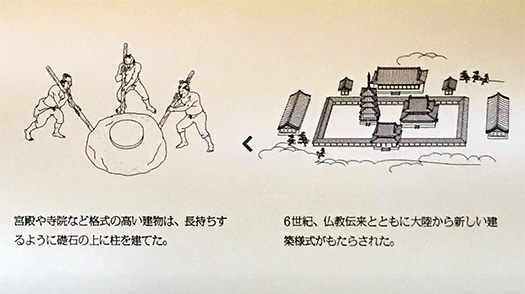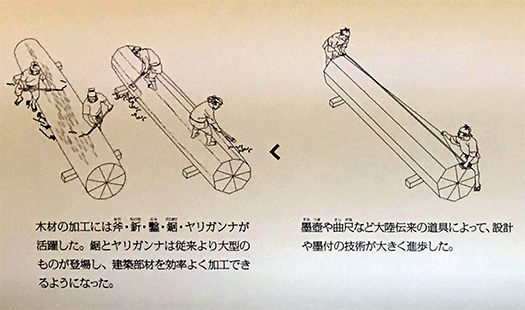


さて古代の日本列島での木造技術を見てきたけれど、
やがてアジア世界との交流が本格的に始まっていく。
天皇制というシステムと統一国家としての統治思想として鎮護国家政策で
各地で国分寺・国分尼寺が造営されて建築として
たぶん「見たこともない」キラキラとしたものとして
この列島の人々の心を占領していったに違いない。
中央集権国家体制の構築と、アジア的律令体制とが一体化して導入された。
建築の流儀として、そのデザイン細部まで入り込んできた。
見たような「出雲大社神殿」のような巨木建築の志向性とはかなり違いがある。
個人的には日本史では奥州での「産金」が大きな影響を及ぼしたと思います。
奈良期に大仏を造営したけれど鍍金にあたって国内でついに産金したことは、
「経済大国」ニッポンの初源体験だったのではと思っています。
四天王寺、法隆寺建設段階ではひたすらアジア世界価値感の導入だったものが、
人口増、経済発展が進みさらに自国内での産金によって
ジャパンasNO1みたいな自信が社会に充満していったのではないか。
その後のヤマト朝廷支配、その基本体制の定着にとって、
産金による自国への自信というものは大きかったのではないか。
天智期での白村江敗戦以降の中国からの脅威が律令体制の積極導入につながり、
仏教文化の積極受容が進められアジア世界への普遍化の流れがあったものが
自国産金で一気に自信回復した、と思えるのです。
そしてその産金地帯が日本権力体制の「汽水域」のような地域だったことが
その後の東北地方の政治動乱の伏線になっていった。
法隆寺建築はそのような国家の状況の中で象徴的な建築営為だった。
竹中大工道具館展示ではアジア世界からの技術導入的に捉えられている。
たしかにそういう側面は大きかっただろうけれど、一方で三内丸山、
出雲神殿建築の木造技術伝統がそれを容易に受容させたとも思える。
礎石の考え方も、出雲神殿でも掘っ立ての基礎部分には多くの砕石が多密度。
技術の受容に当たってたぶん、簡単に「応用」として土着できたのだと思う。
明治の西洋文化導入でも「世界の驚異」的なペースで進めたように。
ノコギリやヤリカンナなど道具は先進のものが導入されただろうけれど、
その使い方は相当スピードで技術文化が定着していった。
法隆寺の建設が想定創建年607年、そこから国分寺建設開始が741年。
それまでの建築スタイルから移行し、それが全国で一斉に建築できるまで
底堅い技術基盤が確立したのだと考えると興味深い。
多数の新技術・新ツールを使いこなす職人が全国的にネットワーク形成された。
日本の歴史人口は上智大学経済学部教授・鬼頭宏さん資料で
奈良期の725年で450万人ほど。その人口規模で全国のクニで造営された。
その時代の最先端技術職人がそれを可能にさせたということ。
典型的な「技術史」と考えるとテーマとして面白いと思われます。
English version⬇
[Introduction of building technology from the continent: Horyuji Temple / Good Japanese House ㊳-10]
Well, I’ve seen the wooden technology in the ancient Japanese archipelago,
Eventually, exchanges with the Asian world will begin in earnest.
With the system of the emperor system and the guardian state policy as the idea of governance as a unified nation
Kokubunji Temple and Kokubunnanji Temple were built in various places as architecture
Maybe as a “never seen” glitter
It must have occupied the hearts of the people of this archipelago.
The construction of a centralized national system and the Asian decree system were introduced in an integrated manner.
As an architectural style, the details of the design have been taken into consideration.
There is a considerable difference from the orientation of giant tree architecture such as the “Izumo Taisha Shrine” that you saw.
Personally, I think that “gold production” in Oshu had a great influence on Japanese history.
The Great Buddha was built in the Nara period, but the fact that it was finally plated in Japan was
I think it was the first experience of “economic power” Japan.
At the construction stage of Shitennoji and Horyu-ji, the introduction of Asian world value was earnestly introduced.
Due to population growth, economic development, and domestic gold production
I think society was filled with self-confidence like Japan as NO1.
For the subsequent Yamato court rule and the establishment of its basic system
I think the confidence in their own country from the money they produced was great.
The threat from China after the defeat of Baekgang in the Tenji period led to the active introduction of the decree system.
The positive acceptance of Buddhist culture has been promoted and there has been a trend toward universalization in the Asian world.
It seems that the self-confidence was restored at once with the domestic money.
And that the gold-producing area was a region like the “brackish water area” of the Japanese power system.
It became a hint of political turmoil in the Tohoku region after that.
Horyuji architecture was a symbolic architectural activity in such a national situation.
At the Takenaka Carpentry Tools Museum exhibition, it is seen as a technology introduction from the Asian world.
I’m sure that aspect was big, but
On the other hand, it seems that the wooden technology tradition of Sannai Maruyama and Izumo Temple architecture easily accepted it.
Even in the Izumo Temple, there are many crushed stones in the foundation of the digging.
In accepting the technology, I think it could have been easily indigenous as an “application”.
It seems that the introduction of Western culture in the Meiji era proceeded at a “world wonder” pace.
Advanced tools such as saws and spear canna would have been introduced,
The technical culture became established at a considerable speed in its usage.
The construction of Horyuji Temple is assumed to be in 607, and the construction of Kokubunji will start in 741.
From the previous architectural style to a new style, until it can be built all over the country
It is interesting to think that a solid technological foundation has been established.
A nationwide network of craftsmen who master a large number of new technologies and tools has been formed.
The historical population of Japan is based on materials by Hiroshi Kito, a professor at the Faculty of Economics, Sophia University.
About 4.5 million people in 725 during the Nara period. It was built in Kuni all over the country with its population size.
The state-of-the-art craftsmen of that era made it possible.
Thinking of it as a typical “history of technology”, it seems to be an interesting theme.
Posted on 8月 9th, 2021 by 三木 奎吾
Filed under: 住宅マーケティング, 歴史探訪







コメントを投稿
「※誹謗中傷や、悪意のある書き込み、営利目的などのコメントを防ぐために、投稿された全てのコメントは一時的に保留されますのでご了承ください。」
You must be logged in to post a comment.